By Sophie Lamb, Teton Conservation District Intern
Jackson Hole High School is home to six acres of Kentucky bluegrass. High school senior Sophie Lamb is working to change that.
Western yarrow, one of the flowers in the High School Pollinator Garden.
Despite its distinctly American name, Kentucky bluegrass is a non-native grass species from Europe and North Africa that was initially brought to North America by early settlers to supplement grasslands for cows, sheep, and other grazers. Though the plant itself does not directly harm ecosystems or waterways, the way in which it is managed—through excessive watering, overfertilization, and mowing—coupled with its role in replacing biodiverse native ecosystems with monocultures, has caused concern in recent years.
Because Kentucky bluegrass is not native, it does not offer a natural habitat for native pollinators, nor does it naturally grow and remain healthy in drier, more basic, Wyoming soil. Furthermore, Kentucky bluegrass's shallow root system makes it especially vulnerable to dry seasons, meaning it requires more watering and fertilizing than native species to survive. As wildfire risk increases and droughts lengthen, the species is becoming increasingly impractical at the scale it’s currently used.
Observing these issues inspired Sophie to seek out a small grant from Teton Conservation District to construct a native plant pilot plot at the high school. The plot is intended to test which species are more successful in the school’s microclimate and potentially be used to supplement the bluegrass surrounding the school. This would decrease the amount of water, fertilizer, and maintenance necessary for the school's landscaping while offering a thriving environment for pollinators, birds, and other species.






The 550 sq. ft. plot is currently located on the southern side of the high school and contains blanket flower, Rocky Mountain penstemon, western yarrow, wild bergamot, and smooth aster from Piney Island Native Plants, as well as Rocky Mountain fescue, sheep fescue, creeping red fescue, Idaho fescue, thickspike wheatgrass, bottlebrush squirreltail, Snake River wheatgrass, slender wheatgrass, bluebunch wheatgrass, streambank wheatgrass, showy milkweed, fringed sage, aspen daisy and basin wildrye from plugs germinated by Vertical Harvest.
To learn more about ways you can make your lawn more environmentally friendly, check out the Trout Friendly Lawns program, or reach out to Teton Conservation District’s native plant specialist Morgan Graham (morgan@tetonconservation.org or 307-733-2110)


